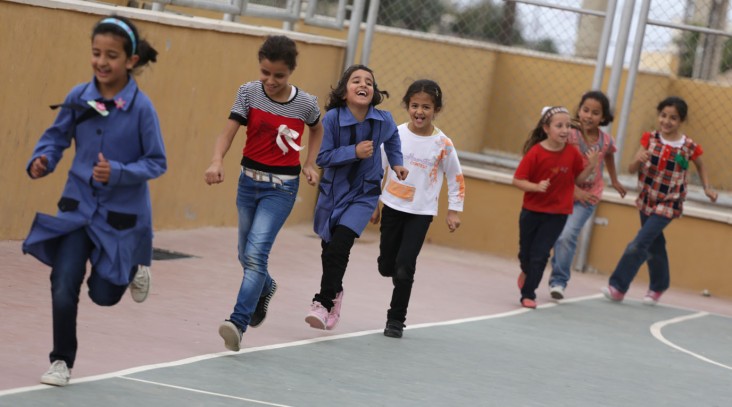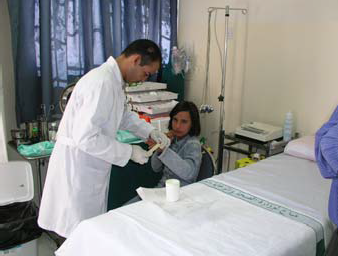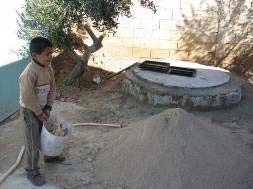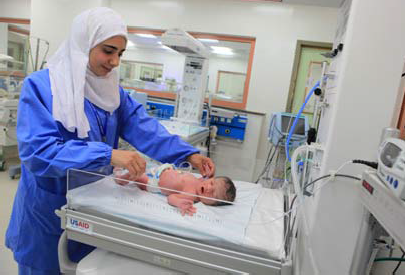Essential Public Services Improved
OVERVIEW

For more than five decades, USAID has helped build Jordan’s health, education, and water systems. Today, water scarcity and rapid population growth pose threats to Jordan’s stability and survival. Maintaining and improving Jordanians’ standard of living in the future depends on the Government of Jordan’s (GOJ) ability to strengthen the delivery and quality of basic essential services. Jordan faces increased pressure on these services due to a shortage of water, rapid population growth and the large influx of refugees from the region.
CHALLENGES
Scarce Water Resources
With a national population that is projected to double by 2047, a large youth bulge, and a growing number of refugees, Jordan’s scarce natural resources – including water and energy – are under additional strain.

Pressures on Healthcare Services
Recognizing that population increases can hinder socioeconomic progress, the GOJ set a goal of reducing the 2012 fertility rate of 3.5 children per woman to 3.0 by 2017, highlighting the need for family planning and reproductive health services. Although Jordan has experienced significant reductions in maternal and infant mortality levels in recent years, pressure on the health system now threatens to reverse these achievements. Since the crisis in Syria began, approximately 629,000 registered refugees have entered the country. Approximately 85 percent live among host communities and rely on Jordanian social and health services. The increased demand on the health system has negatively impacted the timeliness and quality of service delivery, as limited resources are unable to meet the needs of both the expanding Jordanian and refugee populations.

Need for Higher-Quality Education and Increased Youth Engagement
The education sector also faces several challenges that are hindering Jordan’s ability to achieve sustainable, equitable growth. While both boys and girls are not achieving educational goals, girls consistently outperform boys due to the poor learning environments, outdated learning materials, and teachers who lack the necessary training in boys’ schools. In addition, while primary school enrollment nears 97 percent, reading and math comprehension rates in early grades remain dramatically low. Furthermore, youth who leave the formal education sector have few options available to them, either in alternative education structures, avenues toward employment, or civic engagement.
CURRENT PROGRAMS

USAID’s investments in the water sector focus on improving water infrastructure; strengthening management of water resources; and maximizing the conservation of agricultural water.
USAID seeks to increase access to quality health services, while building sustainability and resilience into the national health system. USAID investments focus on ensuring the GOJ continues to deliver quality maternal, newborn and child health care and reproductive health services. USAID also focuses on strengthening the resiliency of Jordan’s health system through sustainable health systems strengthening interventions targeting human resources management of the health work force, health financing governance, and disease surveillance capacity of the public sector.
In education, USAID programs support the GOJ to reform the educational system by building the capacity of teachers and administrators, and through school construction and rehabilitation. USAID works with the GOJ on strengthening reading and math skills in the early grades both inside the classroom and in communities, as well as providing psychosocial training to teachers. USAID is working to prevent youth from dropping out of school and expanding and enhancing non-formal education for youth who have dropped out. Additionally, USAID works with the Ministry of Education to improve planning, access to best practices, information management, accountability, and inclusive and transparent decision making.
IMPACT & RECENT ACHIEVEMENTS
- Improved education for students across the country by providing thousands of educators with professional and leadership skills, promoting professional recognition, and preparing them to support a healthy, caring school environment.
- Provided training to more than 20,000 teachers. Built 28 new schools, expanded and refurbished 117 existing schools, and renovated 609 kindergarten classrooms.
- Improved fresh water and sanitation services for more than one-third of Jordan’s population, including the construction of a water supply plant that provides roughly 30 percent of Amman’s water supply.
- Built and renovated critical infrastructure since 2000 to help increase the water supply and wastewater services for more than 2 million people in north Jordan.
- Reduced water losses and maximized the impact of the Disi water aquifer, enabling the pumping of 100 million cubic meters of water to Amman and northern Jordan each year.
- Improved farmers’ use of hydroponic technologies which increased crop yield and reduced water use as much as 40%.
- Helped reduce maternal mortality from 41 deaths/100,000 live births in 1997 to 19 deaths/100,000 live births in 2008, and infant mortality from 30 deaths/1,000 live births in 1997 to 17 deaths/1,000 live births in 2012.
- Ninety-nine percent of all deliveries now take place in health facilities, many renovated by USAID.
- Introduced post-partum family planning services in public hospitals, purchased or renovated family planning clinics, and reached 1.6 million women with community-level and in-home health counseling.
- Renovated and modernized 318 public-sector clinics, 31 NGO-sector clinics and 25 public-sector hospital departments.








Comment
Make a general inquiry or suggest an improvement.